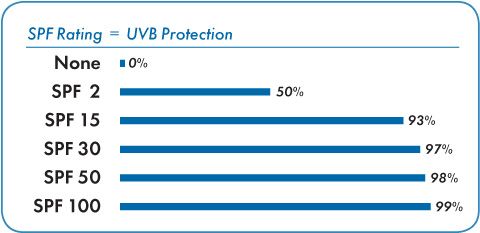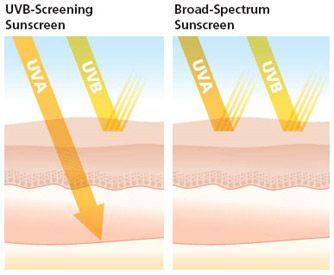UVA, UVB? What?
6/6/2014
Life can be cruel. You finally decide to make a commitment to your health by wearing sunscreen daily and then you show up to the sunscreen aisle and are completely overwhelmed. UVA, UVB? What?
We feel your pain. Picking a sunscreen can be difficult, but there is a system in place to help you know which products can offer you the protection you need.
Sunscreen basics
The sunlight that reaches us is made up of two harmful types of rays: long wave ultraviolet A (UVA) and short wave ultraviolet B (UVB).
UVB
UVB rays are those that burn the outer most layer of skin. They play a key role in the development of skin cancer and the intensity of UVB rays varies by season, location and time of day.
Sun protection factor (SPF) signifies protection against UVB rays. SPF is a rating of the amount time it would take you to sunburn when you are wearing sunscreen versus when you are not. For example, if you'd normally burn in 10 minutes, SPF 15 multiplies that by a factor of 15, meaning you could go 150 minutes before burning.

Our Medical Director, Dr. Danny Groisser suggests using SPF 30 because the protection that higher SPFs offer is almost negligent.
UVA
UVA rays are the ones we are most exposed to; in fact, about 95% of the UV rays that reach us are UVA. UVA rays penetrate the skin more deeply than UVB and are responsible for skin aging, wrinkling and skin cancer. Unlike UVB rays, UVA rays are present with equal intensity throughout the daylight hours and year-round.
Unfortunately, there is no system in place for measuring how well a sunscreen protects against UVA (remember SPF only refers to UVB); instead, you need to check the ingredients. Scan the label for the word broad spectrum and more than one of the following ingredients: avobenzone (Parsol 1789), Mexoryl, titanium dioxide or zinc oxide.
Check the date
Sunscreens are designed to remain at original strength for up to three years. This means that you can use leftover sunscreen from one year to the next.
Some sunscreens include an expiration date — a date indicating when they're no longer effective. Discard sunscreen that is past its expiration date. If you buy sunscreen that doesn't have an expiration date, write the date of purchase on the bottle. Also, discard sunscreen that is more than 3 years old, has been exposed to high temperatures or has obvious changes in color or consistency.Keep in mind, however, that if you use sunscreen generously and frequently, a bottle of sunscreen shouldn't last from one year to the next.
In summary, when shopping for sunscreen you need to buy a product that offers UVB protection (check the SPF) and UVA protection (check the ingredients – or look for indication of Broad Spectrum). Also, write your purchase date on any bottle you buy to prevent yourself from using expired sunscreen.
Help your friends and family by sharing this article. They may be just as overwhelmed as you are by the sunscreen aisle and would love some guidance. Better yet, go shopping together! Living SunSmart is easier when you have support.
Image credits: photo (www.skincancer.org), chart (www.beyondcoastal.com)

